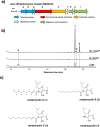Cariogenic Streptococcus mutans Produces Tetramic Acid Strain-Specific Antibiotics That Impair Commensal Colonization
- PMID: 31906623
- PMCID: PMC7150634
- DOI: 10.1021/acsinfecdis.9b00365
Cariogenic Streptococcus mutans Produces Tetramic Acid Strain-Specific Antibiotics That Impair Commensal Colonization
Abstract
Streptococcus mutans is a common constituent of dental plaque and a major etiologic agent of dental caries (tooth decay). In this study, we elucidated the biosynthetic pathway encoded by muc, a hybrid polyketide synthase and nonribosomal peptide synthetase (PKS/NRPS) biosynthetic gene cluster (BGC), present in a number of globally distributed S. mutans strains. The natural products synthesized by muc included three N-acyl tetramic acid compounds (reutericyclin and two novel analogues) and an unacylated tetramic acid (mutanocyclin). Furthermore, the enzyme encoded by mucF was identified as a novel class of membrane-associated aminoacylases and was responsible for the deacylation of reutericyclin to mutanocyclin. A large number of hypothetical proteins across a broad diversity of bacteria were homologous to MucF, suggesting that this may represent a large family of unexplored acylases. Finally, S. mutans utilized the reutericyclin produced by muc to impair the growth of neighboring oral commensal bacteria. Since S. mutans must be able to out-compete these health-associated organisms to persist in the oral microbiota and cause disease, the competitive advantage conferred by muc suggests that this BGC is likely to be involved in S. mutans ecology and therefore dental plaque dysbiosis and the resulting caries pathogenesis.
Keywords: antibacterial bioactivity; biosynthesis; oral microbiome; reutericyclin; small molecule.
Conflict of interest statement
The authors declare no competing financial interest.
Figures




References
-
- (2018) Global, regional, and national incidence, prevalence, and years lived with disability for 354 diseases and injuries for 195 countries and territories, 1990–2017: a systematic analysis for the Global Burden of Disease Study 2017. Lancet 392 (10159), 1789–1858. 10.1016/S0140-6736(18)32279-7. - DOI - PMC - PubMed
Publication types
MeSH terms
Substances
Grants and funding
LinkOut - more resources
Full Text Sources
Other Literature Sources
Medical
Miscellaneous

